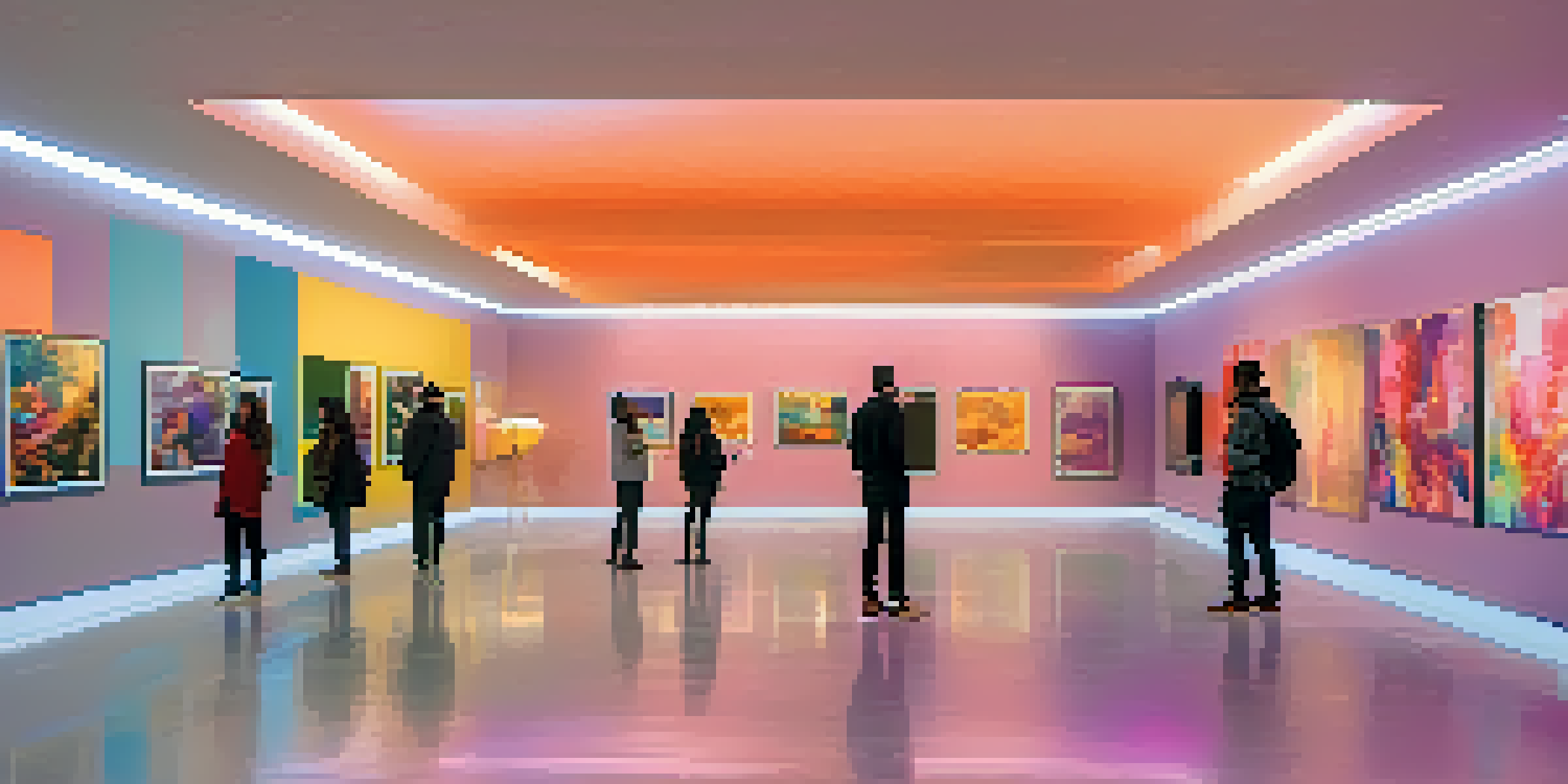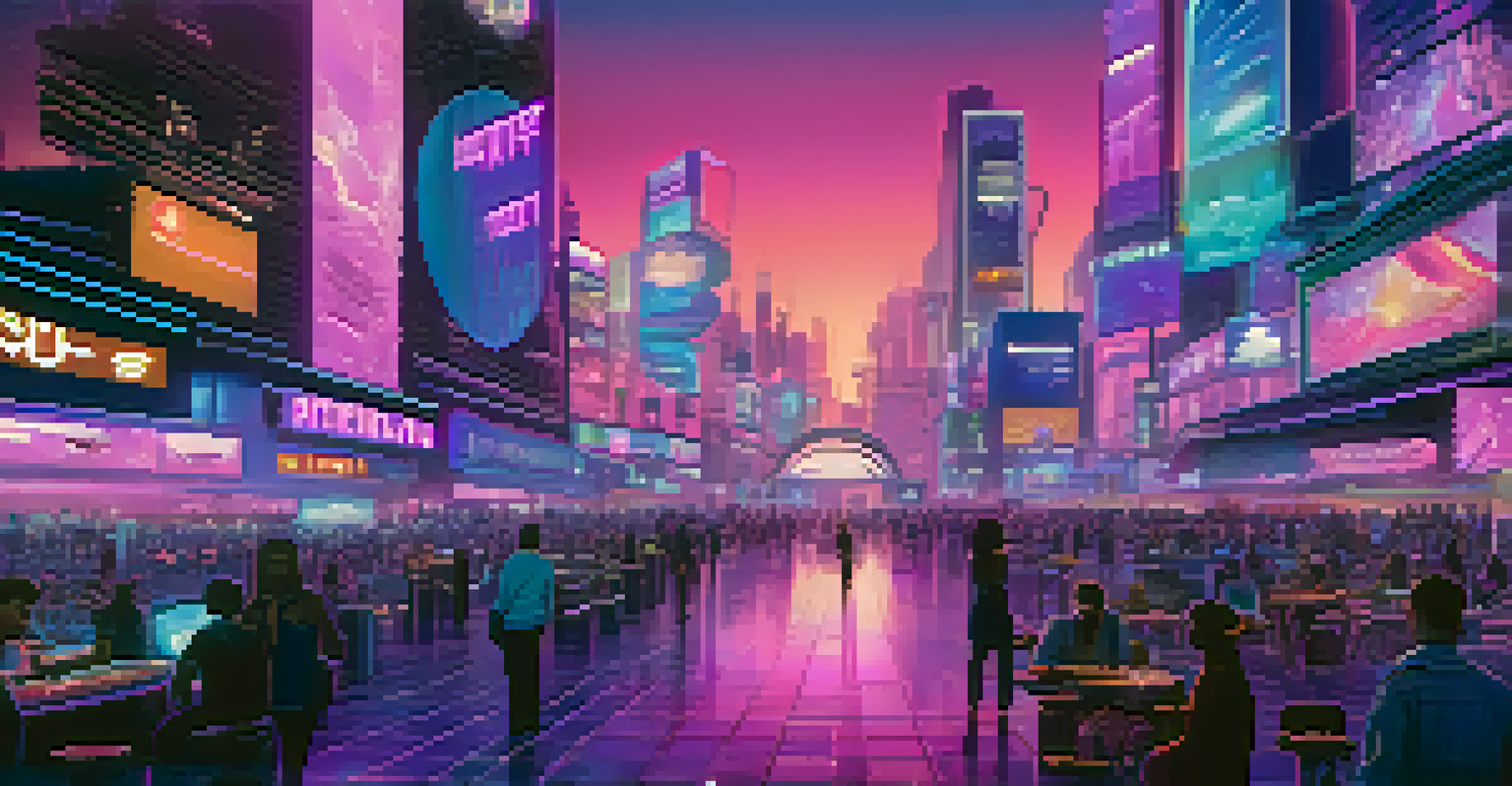NFTs as Digital Assets: Their Role in Metaverse Economies

Understanding NFTs: The Building Blocks of Digital Ownership
NFTs, or non-fungible tokens, are unique digital assets that represent ownership of a specific item or piece of content, like art or music. Unlike cryptocurrencies such as Bitcoin, which are interchangeable, NFTs are one-of-a-kind, making them ideal for representing digital collectibles. This uniqueness is secured using blockchain technology, ensuring that each NFT has a verifiable history of ownership and authenticity.
NFTs are a way to establish ownership in a digital world where ownership was previously impossible.
Imagine owning a rare baseball card; its value comes from its scarcity and provenance. Similarly, with NFTs, collectors and artists can create, buy, and sell digital assets in a way that was never possible before. This opens up new avenues for creativity and commerce, especially in virtual spaces where traditional ownership concepts don't apply.
As the metaverse continues to expand, NFTs are becoming essential for establishing ownership rights and transferability within these digital realms. They empower users to have control over their digital possessions, whether that’s virtual real estate, digital art, or even avatars, making them a crucial element of metaverse economies.
The Metaverse: A New Frontier for Digital Interaction
The metaverse is often described as a collective virtual space where users can interact with a computer-generated environment and other users in real-time. Think of it as a blend of social media, online gaming, and virtual reality, all rolled into one immersive experience. This environment is constantly evolving, creating opportunities for businesses and individuals to engage in ways that were previously unimaginable.

As more people gravitate toward these digital spaces, the demand for virtual goods and experiences skyrockets. This opens the door for NFTs to serve as the backbone of transactions, providing a way for users to buy, sell, and trade digital assets seamlessly. The metaverse is not just a playground; it’s becoming a marketplace where digital economies thrive.
NFTs Enable Unique Digital Ownership
NFTs are unique digital assets that secure ownership of items like art and music through blockchain technology.
Moreover, the integration of NFTs into the metaverse allows creators to monetize their work, whether through virtual galleries, gaming items, or digital fashion. This democratization of creativity leads to a richer, more diverse economic landscape, as artists and developers can directly connect with their audience without traditional gatekeepers.
NFTs and Virtual Real Estate: A Match Made in Heaven
Virtual real estate is one of the hottest commodities in the metaverse, with platforms like Decentraland and Sandbox selling plots of land as NFTs. Owning virtual land allows users to build experiences, host events, or even create marketplaces, making it a powerful asset in this digital economy. Just as location matters in the physical world, the same principle applies in the virtual realm.
The metaverse is not just a playground; it’s becoming a marketplace where digital economies thrive.
Investors are flocking to buy virtual properties, sometimes for millions of dollars, envisioning future developments and the potential for profit. For instance, owning a prominent spot in a bustling metaverse can provide advertising opportunities or serve as a hub for community gatherings, driving traffic and engagement. This trend mirrors the way physical real estate has historically been viewed as a stable investment.
However, the volatility of the digital real estate market means that potential buyers should conduct thorough research before jumping in. As the metaverse continues to grow, understanding the dynamics of virtual land ownership will be crucial for navigating this emerging landscape.
Gaming and NFTs: Revolutionizing Player Ownership
The gaming industry is one of the first sectors to fully embrace NFTs, fundamentally changing how players interact with in-game assets. Traditionally, players would purchase items or skins, but they were never truly owned; they existed within the confines of the game. NFTs allow players to own, trade, and sell their items outside of the game, creating a new dimension of value.
For example, imagine you earn a rare sword in a game that you can sell or trade, rather than just having it vanish if you stop playing. This shift not only enhances the gaming experience but also allows players to invest in their passion, as their in-game achievements can translate into real-world value. It’s a win-win situation where players feel a deeper connection to their gaming experience.
Metaverse Drives Demand for NFTs
As the metaverse expands, NFTs become essential for transactions and ownership rights within these digital spaces.
Moreover, integrating NFTs into gaming also opens the door for cross-game compatibility, where assets can be used across different platforms. This interconnectedness could lead to a more cohesive gaming ecosystem, where players can carry their achievements and investments from game to game, further solidifying the value of their digital assets.
Art and NFTs: Redefining Digital Creativity
Digital artists have found a powerful ally in NFTs, which have transformed how they monetize their work and connect with audiences. By minting their art as NFTs, creators can sell their pieces directly to collectors, eliminating the need for galleries or intermediaries. This direct-to-consumer model not only increases profits for artists but also creates a more personal relationship with their audience.
The famous NFT artwork, 'Everydays: The First 5000 Days' by Beeple, sold for a staggering $69 million at auction, showcasing the potential of digital art in this new economy. This case illustrates how NFTs can elevate the status of digital works, giving them a place in the art world alongside traditional mediums. Artists are no longer constrained by physical limitations, allowing for more innovative and diverse expressions.
Additionally, NFTs enable artists to earn royalties on secondary sales, offering a continuous income stream whenever their work is resold. This reimagining of ownership and value fosters a more sustainable creative ecosystem, where artists can thrive while being recognized for their contributions.
Challenges and Criticisms of NFTs in the Metaverse
Despite their growing popularity, NFTs are not without challenges and criticisms. One major concern revolves around environmental impacts, as the blockchain technology that underpins many NFTs requires significant energy consumption. Critics argue that this creates a carbon footprint that contradicts efforts toward sustainability, prompting discussions on finding greener blockchain solutions.
Moreover, the speculative nature of the NFT market can lead to bubbles, where prices soar and then crash, leaving investors and creators at a loss. This unpredictable volatility can deter potential buyers and artists who may be hesitant to enter a market that seems unstable. Education and transparency are key in addressing these concerns and building trust within the community.
Challenges Facing NFTs Persist
The NFT market faces environmental concerns, speculative volatility, and issues with copyright that need addressing for sustainable growth.
Lastly, issues related to copyright and intellectual property rights continue to surface, as disputes arise over who truly owns digital content. Clearer regulations and guidelines are necessary to protect creators and consumers alike, ensuring that the NFT space matures in a way that is fair and equitable for all participants.
The Future of NFTs in Metaverse Economies
As we look ahead, the role of NFTs in metaverse economies is poised for significant growth and evolution. With advancements in technology and increasing user adoption, NFTs are likely to become more integrated into everyday digital interactions. This could lead to new forms of commerce, social engagement, and entertainment, shaping how we perceive ownership and value in virtual spaces.
Future developments may also include more user-friendly platforms for creating and trading NFTs, making it easier for individuals and businesses to participate. Imagine a world where anyone can mint their own NFT with just a few clicks, fostering an even broader range of creativity and innovation. This democratization will further enrich the metaverse ecosystem.

Ultimately, the successful integration of NFTs into the metaverse will hinge on addressing existing challenges while embracing the potential for new opportunities. By fostering collaboration among creators, developers, and users, the metaverse can become a thriving digital economy, where NFTs play a pivotal role in defining the landscape of future interactions and transactions.